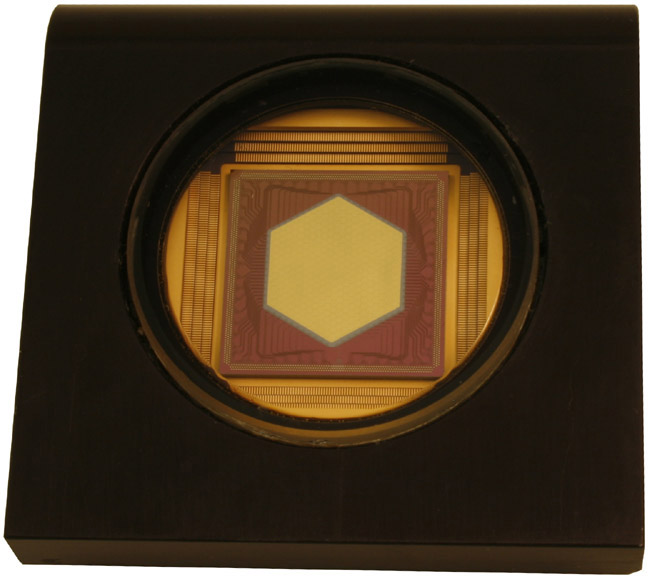Advances in deformable mirrors for astronomical adaptive optics
The search for planets outside our solar system is a major focus for the astronomical community. Over the past decade, a number of high-contrast imaging techniques have been developed to enable direct detection of these exoplanets, overcoming the challenges of imaging extremely dim planets circling bright stars in distant solar systems. Of extreme importance to nearly all of these new instruments and techniques is the need for unprecedented optical contrast and resolution, which in turn requires active, precise control of the imaging wavefront and compensation of any wavefront errors.1–3
Adaptive optics (AO) has become indispensable as a means to compensate for wavefront errors (aberrations) introduced by atmospheric turbulence in large ground-based telescopes. AO also corrects for alignment and polishing errors of optical components in space-based astronomical instruments with sub-nanometer precision. The AO process measures the aberrations, however small, and corrects for them by changing the shape of a deformable mirror (DM) in the optical system to adjust the wavefront. The resulting gains in resolution and contrast have led to exciting recent advances in the observation of exoplanets, characterization of planetary rings and atmospheres, and study of galactic structure.

Microelectromechanical systems- (MEMS-) based DMs are an emerging class of wavefront correctors used in an expanding field of applications including biomedical imaging, microscopy, pulse shaping, free-space laser communications, and astronomical imaging. These DMs are manufactured using a process similar to that of integrated circuits (polysilicon surface micromachining). They are extremely lightweight and compact, consume very little power, and can assume shapes with sub-nanometer precision and repeatability without hysteresis, making them ideal candidates for space-based operation. In addition, they are economically scalable to arrays of thousands of actuators, which is needed for both ground- and space-based imaging.
We have supplied these MEMS DMs to the AO community for over a decade and have been advancing our DM technology to suit the needs of astronomical telescope users. We have developed DMs with continuous facesheets and piston-only mirror segments as well as tip-tilt-piston mirror segments, using highly reliable electrostatic actuators with up to 6μm of stroke and 4092 actuators (see Figure 1). Our MEMS DMs have been used in many AO testbeds for astronomical imaging systems, and have been demonstrated in on-sky operations at the Nickel 1m telescope at the Lick Observatory on Mount Hamilton, CA—see Figure 2—in the Visible light Laser Guidestar Experiments (ViLLaGEs).4, 5 The 3.5μm stroke, 140-actuator DM used in this instrument can provide precise atmospheric wavefront compensation owing to its ability to correct for high spatial frequency aberrations with sub-nanometer precision at rates >2kHz. It demonstrated diffraction-limited imaging in the R through I bands in both open- and closed-loop operation. This system, which resides permanently at the observatory, has demonstrated the robustness and feasibility of the use of MEMS DMs in astronomical AO.

A 4092-actuator continuous facesheet DM with 4μm of actuator stroke and a full active aperture of 25.2mm was developed for the Gemini Planet Imager (GPI), in which the DM will be used to correct for high-order aberrations induced by the atmosphere. This high-contrast imaging instrument will be deployed in the Gemini South Telescope—see Figure 3—in 2012, where it is expected to image planets and achieve a contrast of 10−7 at separations of 0.2–1arcsec from the parent star. Owing to its high-precision wavefront control, the GPI will be able to produce diffraction-limited images for light with wavelengths of 0.9–2.4μm. This precise control is the result of new technologies and algorithms developed at Lawrence Livermore National Laboratory for the GPI instrument, including spatially filtered wavefront sensors, Fourier transform wavefront reconstructors, and a high-precision interferometric calibration system, as well as the high-order wavefront compensation provided by our MEMS DM.6
NASA is working on a number of potential space telescope projects to further push the ability to find extrasolar planets. Locating instruments outside of Earth's atmosphere allows for better imaging, which supports the goal of finding an Earth-like planet capable of supporting life. The compact size, light weight, and low power consumption of our MEMS DMs make them enabling components for high-contrast imaging systems in these projects. Both our 1020-actuator continuous facesheet device and 331-segment tip-tilt-piston device—see Figure 4—are currently in testbeds where they have demonstrated contrasts as high as 1.3 x 10−6 from 1.2–2.0λ/D and 2×10−8 from 2.0–3.5λ/D (where λ is the wavelength and D the aperture).3 For example, the high contrast imaging test bed at NASA Ames Research Center uses a phase-induced amplitude apodization coronagraph in which shaped mirrors are used to mitigate undesirable diffraction.3 The result is improved light-gathering capability (∼100% throughput) and better angular resolution than that obtained by classical techniques using apodization masks. The DMs in these test beds are used to correct for nanometer-scale residual phase errors and alignment errors in the optical system.
We currently have two projects with NASA to further enhance the ability to image in space using MEMS DMs. The Advanced THousand-Element Nuller-Application (ATHENA) DM Project will expand the size of our tip-tilt-piston device to 1021 segments with 3063 actuators for NASA's visible nulling coronograph instrument for imaging and spectroscopy of exoplanets.7, 8 The other NASA project will produce low-power high-precision electronics capable of 40pm wavefront control. Combined, these advances will represent a leap forward in the ability to achieve high-precision wavefront control with low power, lightweight equipment.
Steven Cornelissen is vice president of engineering and has been active in MEMS DMs research for adaptive optics in microscopy and astronomical imaging for many years. He has been involved in product development and commercialization efforts and led multiple research and development contracts involving advanced optics for astronomical applications.





